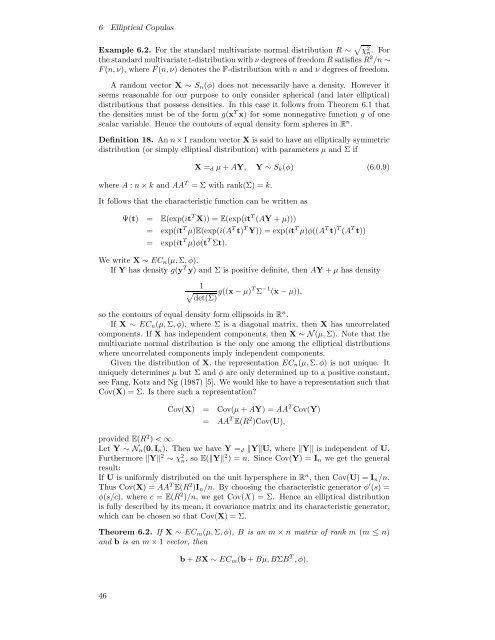Modelling Dependence with Copulas - IFOR
Modelling Dependence with Copulas - IFOR
Modelling Dependence with Copulas - IFOR
Create successful ePaper yourself
Turn your PDF publications into a flip-book with our unique Google optimized e-Paper software.
6 Elliptical <strong>Copulas</strong><br />
Example 6.2. For the standard multivariate normal distribution R ∼ √ χ 2 n . For<br />
the standard multivariate t-distribution <strong>with</strong> ν degrees of freedom R satisfies R 2 /n ∼<br />
F (n, ν), where F (n, ν) denotes the F-distribution <strong>with</strong> n and ν degrees of freedom.<br />
A random vector X ∼ S n (φ) does not necessarily have a density. However it<br />
seems reasonable for our purpose to only consider spherical (and later elliptical)<br />
distributions that possess densities. In this case it follows from Theorem 6.1 that<br />
the densities must be of the form g(x T x) for some nonnegative function g of one<br />
scalar variable. Hence the contours of equal density form spheres in R n .<br />
Definition 18. An n×1 random vector X is said to have an elliptically symmetric<br />
distribution (or simply elliptical distribution) <strong>with</strong> parameters µ and Σ if<br />
where A : n × k and AA T = Σ <strong>with</strong> rank(Σ) = k.<br />
X = d µ + AY, Y ∼ S k (φ) (6.0.9)<br />
It follows that the characteristic function can be written as<br />
Ψ(t) = E(exp(it T X)) = E(exp(it T (AY + µ)))<br />
= exp(it T µ)E(exp(i(A T t) T Y)) = exp(it T µ)φ((A T t) T (A T t))<br />
= exp(it T µ)φ(t T Σt).<br />
We write X ∼ EC n (µ, Σ,φ).<br />
If Y has density g(y T y) and Σ is positive definite, then AY + µ has density<br />
1<br />
√<br />
det(Σ)<br />
g((x − µ) T Σ −1 (x − µ)),<br />
so the contours of equal density form ellipsoids in R n .<br />
If X ∼ EC n (µ, Σ,φ), where Σ is a diagonal matrix, then X has uncorrelated<br />
components. If X has independent components, then X ∼N(µ, Σ). Note that the<br />
multivariate normal distribution is the only one among the elliptical distributions<br />
where uncorrelated components imply independent components.<br />
Given the distribution of X, the representation EC n (µ, Σ,φ) is not unique. It<br />
uniquely determines µ but Σ and φ are only determined up to a positive constant,<br />
see Fang, Kotz and Ng (1987) [5]. We would like to have a representation such that<br />
Cov(X) = Σ. Is there such a representation?<br />
Cov(X) = Cov(µ + AY) =AA T Cov(Y)<br />
= AA T E(R 2 )Cov(U),<br />
provided E(R 2 ) < ∞.<br />
Let Y ∼N n (0, I n ). Then we have Y = d ‖Y‖U, where‖Y‖ is independent of U.<br />
Furthermore ‖Y‖ 2 ∼ χ 2 n,soE(‖Y‖ 2 )=n. Since Cov(Y) =I n we get the general<br />
result:<br />
If U is uniformly distributed on the unit hypersphere in R n ,thenCov(U) =I n /n.<br />
Thus Cov(X) =AA T E(R 2 )I n /n. By choosing the characteristic generator φ ′ (s) =<br />
φ(s/c), where c = E(R 2 )/n, wegetCov(X) = Σ. Hence an elliptical distribution<br />
is fully described by its mean, it covariance matrix and its characteristic generator,<br />
which can be chosen so that Cov(X) =Σ.<br />
Theorem 6.2. If X ∼ EC m (µ, Σ,φ), B is an m × n matrix of rank m (m ≤ n)<br />
and b is an m × 1 vector, then<br />
b + BX ∼ EC m (b + Bµ,BΣB T ,φ).<br />
46
















